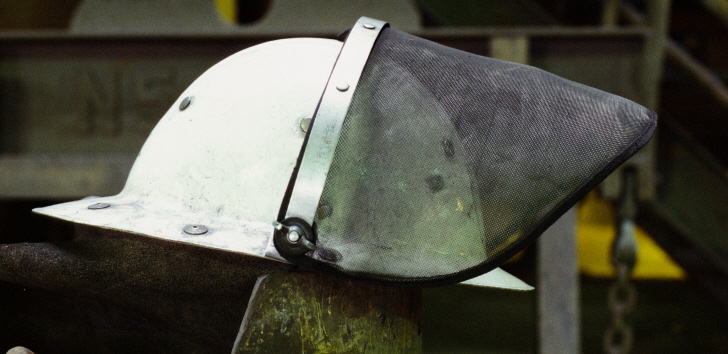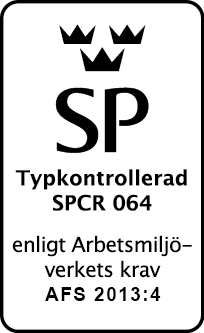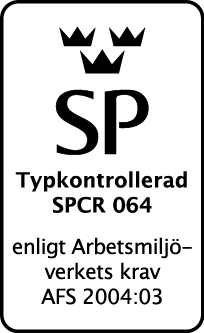Product rules
Much of the legislation applicable to products originates from EU directives and EU regulations. The directives are transposed into Swedish legislation in the form of Acts, Ordinances and regulations. Here, you can read about the rules that apply to machinery, personal protective equipment, simple pressure vessels and pressure equipment, ladders, trestles and scaffolding, as well as work in potentially explosive atmospheres.

Rules for machinery
The requirements of the EU Machinery Directive have been transposed into Swedish regulations
You can read more about the importance of the regulations on machinery for various operators on our page for machinery.
Directive 2006/42/EC on machinery has been transposed into Swedish legislation and now forms the basis for the Swedish Work Environment Authority’s regulations on machinery (AFS 2008:3).
Machinery covered by these rules must fulfil the requirements of the regulations if they are to be:
- Placed on the market, e.g. by manufacturers or importers into the EEA;
- Supplied for use, e.g. by a wholesaler or retailer;
- Taken into use if the machinery has been manufactured for own use.
Machinery covered by these rules must inter alia:
- Meet the essential health and safety requirements stipulated in Annex 1 of AFS 2008:3;
- Be accompanied by a Declaration of Conformity in Swedish (Articles 6 and 19 of AFS 2008:3);
- Be CE marked (Article 6 and Annex 3 of AFS 2008:3);
- Have user instructions in Swedish (Article 6 and Annex 1, paragraph 1.7.4 and Article 19 of AFS 2008:3).
Employers must not use the machinery if these requirements are not met; see Article 7 of the Swedish Work Environment Authority's regulations on the use of work equipment (AFS 2006:4).
The machinery covered by the regulations is stipulated in Article 1 and 3.
The CE marking and Declaration of Conformity must be prepared by the manufacturer or its authorised representative established in the EEA.
Deficiencies in meeting the requirements of AFS 2008:3 may incur fines, injunctions or prohibitions imposed by the Swedish Work Environment Authority.
New rules concerning the design of personal protective equipment, 21 April 2018
Regulation (EU) 2016/425 of the European Parliament and of the Council of 9 March 2016 on personal protective equipment and repealing Council Directive 89/686/EEC entered into force on 21 April 2018, simultaneously repealing the Swedish Work Environment Authority regulations on the design of personal protective equipment (AFS 1996:7). The EU Regulation applied directly and will therefore not be transposed into Swedish legislation.
Regulation AFS 1996:7 still applies to personal protective equipment already placed on the market under the old directive.
Regulation on personal protective equipment, EUR-Lex website, opens in new window
Rules concerning personal protective equipment
Personal protective equipment must comply with the requirements of the regulations in order to be placed on the market, for example supplied by a manufacturer or importer in the EEA, or provided for use, for example by a wholesaler or retailer, or taken into use.
Requirements regarding personal protective equipment covered by Regulation (EU) 2016/425 on personal protective equipment include:
- Fulfilment of the essential health and safety requirement in Annex 1;
- Establishment of a Declaration of Conformity;
- CE marking of the product;
- Provision of user instructions in Swedish.
‘Personal protective equipment’ refers to any equipment which is intended to be worn or held by a person for protection against one or more health or safety deficiencies. These may include respiratory protection, eye and face protection, foot protection, fall protection, protective clothing, protective gloves or protective helmets.
Rules concerning simple pressure vessels and pressure equipment
Rules concerning simple series-produced pressure vessels in steel or aluminium for air or nitrogen gas can be found in the regulations on simple pressure vessels (AFS 2016:2 Simple pressure vessels). These regulations have been transposed into Swedish legislation from Directive 2014/29/EU of the European Parliament and of the Council of 26 February 2014 on the harmonisation of the laws of the Member States relating to the making available on the market of simple pressure vessels. The regulations supersede AFS 1994:53 and have been in force since 20 April 2016.
Rules for pressure equipment (vessels, piping, units, safety equipment and pressure accessories) can be found in the regulations on pressure equipment (AFS 2016: 1 Pressure equipment). These regulations have been transposed into Swedish legislation from Directive 2014/68/EU of the European Parliament and of the Council of 15 May 2014 on the harmonisation of the laws of the Member States relating to the making available on the market of pressure equipment. The regulations supersede AFS 1999:4 and have been in force since 19 July 2016.
Pressure equipment (AFS 2016:1), regulations
Simple pressure vessels (AFS 2016:2), regulations
Rules for ladders and scaffolding
Ladders, trestles and scaffolding are not regulated by EU directives or EU regulations
Ladders, trestles and scaffolding are not regulated in the Product Safety Directive and therefore national rules apply to these products. The rules can be found in two regulations:
Ladders and Trestles (AFS 2004:3), regulations
Scaffolding (AFS 2013:4), regulations
The supply of ladders and scaffolding is subject to type testing and marking. Requirements differ slightly between ladders and scaffolding.
Requirements for ladders
Ladders must be:
- Type-tested and have type test certification in accordance with AFS 2004:3; or
- Certified in accordance with a standard and have a certificate in accordance with the regulations AFS 2004:3.
See also the regulations on ladders and trestles (AFS 2004:3, Articles 4-7).
Ladders and trestles (AFS 2004:3), regulations
N.B.! Until 2010, the European standards in the EN 131 series were not equivalent, but are now equivalent for leaning and free-standing ladders (not for extension, section and combination ladders) under the following conditions:
- Certification is in accordance with the editions SS-EN 131-1:2015+A1:2019, EN 131-2:2010 and EN 131-4 (where applicable).
- The A deviations for Sweden in Annex A (EN131-1), Annex B (EN 131-2) and Annex B (EN 131-4) have been taken into account.
Therefore, certification/correspondence in relation to older editions of the standards in the EN 131 series is still not equivalent.
Ladders must also be clearly and permanently marked with the manufacturer’s or importer’s name, year of manufacture and type designation.
Type-tested ladders must also be marked as type-tested in accordance with these regulations with the name of the accredited body and the number of the type test certificate.
Certified ladders must be marked with reference to the standard applied (see Articles 8-9 of the regulations on ladders and Trestles (AFS 2004:3)).


Requirements for scaffolding
Prefabricated scaffolding, components for prefabricated scaffolding and couplings must be type-tested by an accredited certification body; see Article 10 of the regulations on Scaffolding, AFS 2013:4. Type testing may also be performed by an accredited body in another country in the EEA. The level of safety of the scaffolding concerned must be comparable to scaffolding that has been type-tested in Sweden.
‘Prefabricated scaffolding’ means scaffolding where all or some parts are prefabricated with given dimensions and which has fixed connection points; see Article 4 of the regulations on Scaffolding (AFS 2013: 4). The requirement applies to scaffolding with a minimum height of 1.25 m to a horizontal working deck.
Scaffolding must also be marked in accordance with Article 21 of AFS 2013:4 and in accordance with the accredited body’s instructions.
Scaffolding (ADI 512), brochure
Scaffolding (AFS 2013:4), regulations
Working in explosive atmospheres – dust, steam or mist
Dust explosions occur when a cloud of dust ignites. Hazardous dust accumulation usually occurs enclosed in process equipment and can blow up the equipment. Therefore, it is important to choose the right equipment and safe working methods.
Rules are available from the Swedish Work Environment Authority and other authorities
The Swedish Work Environment Authority has stipulated rules governing work where there are risks caused by dust, steam or mist. The Swedish Work Environment Authority has also stipulated rules for manufacturers of non-electrical equipment for potentially explosive atmospheres.
Work in potentially explosive atmospheres (AFS 2003:3), regulations
Equipment for potentially explosive atmospheres (AFS 2016:4), regulations
The Swedish Civil Contingencies Agency (MSB) has stipulated rules for work in potentially explosive atmospheres when handling flammable liquids and flammable gases (SRVFS 2004:7).
The Swedish National Electrical Safety Board has stipulated rules for manufacturers of electrical equipment intended for potentially explosive atmospheres.
Swedish Civil Contingencies Agency website, opens in new window
Swedish National Electrical Safety Board website, opens in new window
EU ATEX Directive transposed into Swedish law
The rules above have transposed the EU ATEX Directive into Swedish law. The ATEX Directive is aimed partly at users and partly at equipment, and applies throughout the EU.
Last updated 2021-09-23

